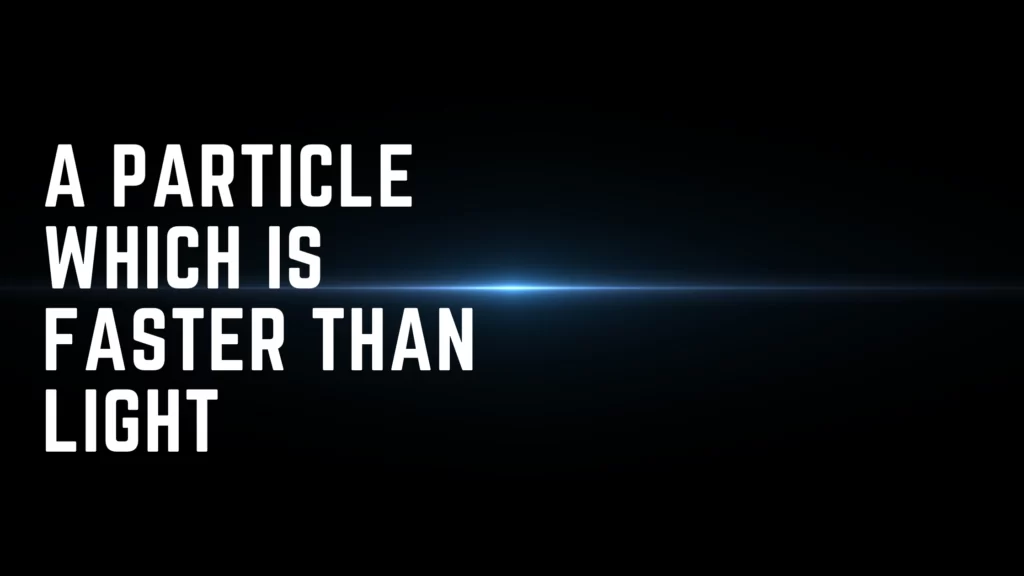Light, the fastest thing in this universe till now. Nothing can travel faster than light. But what if I tell you that there is a particle that can do this. Yes, I’m talking about Tachyon Particles. In this article, we’ll talk about Tachyon Particles and we’ll try to find out that “Are they really faster than light“.

What is Tachyon Particle?
Tachyon particles are hypothetical particles that travel faster than light.

A Tachyon particle is a hypothetical particle that always travels faster than light. For most physicists, it is practically impossible to travel faster than light. Because if any particle can do so then it will not be consistent with the laws of physics. Also if that kind of particle really exists then according to the theory of relativity it can violate the casualties, leading to some logical paradoxes like the predestination paradox and the grandfather paradox.
Grandfather paradox:
It is a paradox of time travel in which inconsistencies occurs by changing the past. It is a quite weird paradox where the paradox’s description is like this: a person travels to the past and kills their own grandfather before the conception of their father or mother, which prevents the time traveller’s existence. The paradox does not exclusively consider the contradiction of killing one’s own grandfather to prevent one’s birth. Rather, the paradox actually thinks about the result of an action that alters the past, since there is a contradiction whenever the past becomes different from the way it was.
There is also a similar kind of paradox called Predestination Paradox, where the thing is quite the same.
Predestination Paradox:
Predestination Paradox is a similar kind of paradox that basically says us that we never can change history. It simply means that things that already happened are always destined to turn out the same way no matter what happens.
This paradox occurs when a person tries to change the past by travelling back in time and becoming a part of the event. And ultimately cause the event he is trying to prevent to take place. This results in a ‘temporal causality loop’.
Let’s try to understand this.
Two events are happening here, event 1 and event 2.
Now event 1 happened in past, which is influencing event 2 in future. Now if event 2 is happening, then event 1 has to happen. So, this thing makes a circular loop of events.
Now if someone tries to change event 1 after experiencing event 2, it’s not possible for him/her. Cause the circular loop ensures that history can’t be altered by any time traveller. And if someone attempts to stop something from happening in the past then instead of stopping it, he/she will be the cause of the event.
There is also a movie named “The Predestination Paradox” on this paradox. If you watch that movie, you can understand how weird and confusing this paradox is.
History of Tachyon Particles:
Gerald Feinberg, a Columbia University physicist was the person who first coined this term, Tachyon in a paper titled “Possibility of faster-than-light particles” in 1967. In this paper, he also introduced us to fields with imaginary mass which is now also known as the Tachyonic field.
Properties:
So, according to relativity theory, a particle will not be able to accelerate faster than the speed of light. But what about a particle that is faster than light from the beginning, from the big bang itself.
If such a particle existed, it would not be able to decelerate itself to travel slower than light. It would have this weird property, that its required energy would decrease as its velocity increased, and hence it would approach its lowest energy state when it approached the speed of infinity. Visa Versa, it would require infinite energy to slow down to the speed of light and would hence never be able to cross that speed limit. This makes the speed of light a two-way barrier to particles traveling at speeds on either side of it
Tachyon Particles have imaginary mass. But here the word “imaginary” doesn’t mean to be something in our imagination. Here the imaginary number indicates the “imaginary numbers”. This is why it is a little bit confusing.
Imaginary Number:
An imaginary number can be defined as a complex number in which the imaginary part of the number is non-zero. We can define it as : a+ib.
Where, a and b both are real numbers and “i” has a value of square root of -1.
i= √-1
It can’t be written as a fraction and also can’t be placed on the regular graph. It requires a kind of complex graph. And this is why we called it imaginary. If a particle is travelling at the speed of light, it’s mass would be zero. And if it is travelling at speed larger than that then the mass is becoming less than zero. Means the mass becomes imaginary mass.
E =mc^2/√(1-v^2/c^2)
Here, v is the speed of the particle and c is the speed of light.
The next property is also weird as well as exciting. Tachyon particles can also travel in the opposite direction through time. So an observer can see them before they are created (with respect to the frame of the observer), depending on the relative configurations between the frames in spacetime.
Theory of Relativity and Tachyon Particles:
Einstein’s “Theory of Relativity” says nothing can move faster than c(speed of light). But tachyon particles can do that. So, how is this possible?
Well, “Theory of relativity” actually says that nothing can speed up to c, but what if it was already going at that speed from the begining, from the Big Bang?
Then actually nothing is violated. The quantum theory of virtual particles is also valid, because it comes into existence and has no speeding up.
Does relativity predict tachyons?
In one line, “It sure does”.
E^2=p^2c^2 + m^2c^4
where E is energy, p is momentum, c is speed of light, and m is rest mass. If we solve this equation for E, a positive and negative root arise and relativity currently concerns with the positive one. But what about the negative one? The negative solution arises from backward motion through time, the counter to the positive solution.
This can be understandable by the switching principle. This principle says that a forward particle will look the exact same as a backward one with its properties reversed. But when a backward or forward particle encounters a photon, that is the transition to its compliment. But we can only see the photon and know that something must have hit our particle. In particle physics this is called as anti-particle. That is why the two have opposite properties, and is an interesting non-quantum approach to proving antiparticles and in this case a tachyon-like particle.
Fun fact:
Particles who have imaginary mass are called Tachyon particles. Now there are another two types of particles called Bradyons and Luxons.
Actually,
- The particles with a non-zero mass that travel slower than light are called Bradyons.
- Particles with zero mass that travel slower than light are called Luxons.
Here is a simple comparison between these 3 types of particles.
- Bradyon: v < c, m²>0
- Luxons: v = c, m²=0
- Tachyons: v > c, m²< 0
References:
What Are Tachyons? – Owlcation







